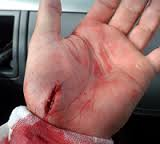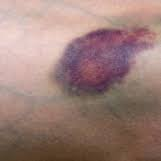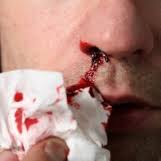|
|
| |
|
|
 Whith bleeds two kinds can be distinguished. External and internal bleeding.
External bleeding can be easily identified and handeled, by methods described below.
Internal bleeding is often difficult to recognize and the best first aid, even in doubt, is a trip to the hospital.
With severe bleeding a victim may not drink or eat.
Whith bleeds two kinds can be distinguished. External and internal bleeding.
External bleeding can be easily identified and handeled, by methods described below.
Internal bleeding is often difficult to recognize and the best first aid, even in doubt, is a trip to the hospital.
With severe bleeding a victim may not drink or eat. |
| |
|
Internal bleeding
|
As an internal bleeding could be very dangerous, you need to be able to recognise it (the symptoms).
 A punch in the stomach or on the head followed by complaints of pain would have to make you alert. A blue/red spot is a point where
blood accumulates under the skin and is thus a first indication that there is internal bleeding.
In the stomach, you will less likely get a color change, but again the formation of a blood bag, which is outside the blood veins
in the abdomen will collect.
With an internal bleeding, the heart will try to get blood to the primary organs, and this will increase the heart rate.
Smaller vessels will be denied blood, causing the skin to become pale and feel colder.
This is easily testable by a capillary refill (CR) test. Squeeze your nails and see how long it takes your finger to get back to
its original color. If this is noticeably longer with a patient, the CR is secondary to more important organs. This can point on to
internal bleeding and shock.
With internal bleeding, it is advisable to put the patient into a lying position and immediately call an ambulance.
Exception: Pulmonary haemorrhage.
A punch in the stomach or on the head followed by complaints of pain would have to make you alert. A blue/red spot is a point where
blood accumulates under the skin and is thus a first indication that there is internal bleeding.
In the stomach, you will less likely get a color change, but again the formation of a blood bag, which is outside the blood veins
in the abdomen will collect.
With an internal bleeding, the heart will try to get blood to the primary organs, and this will increase the heart rate.
Smaller vessels will be denied blood, causing the skin to become pale and feel colder.
This is easily testable by a capillary refill (CR) test. Squeeze your nails and see how long it takes your finger to get back to
its original color. If this is noticeably longer with a patient, the CR is secondary to more important organs. This can point on to
internal bleeding and shock.
With internal bleeding, it is advisable to put the patient into a lying position and immediately call an ambulance.
Exception: Pulmonary haemorrhage.
 A patient with a pulmonary haemorrhage coughs a light red and frothy blood. Again, in the first place: make it as comfortable as
possible to the patient. With strong anxiety and nervousness, a patient coughs a lot more and therefore bleeds more.
Place the patient in the upright position into cushions. Never leave them flat.
A patient with a pulmonary haemorrhage coughs a light red and frothy blood. Again, in the first place: make it as comfortable as
possible to the patient. With strong anxiety and nervousness, a patient coughs a lot more and therefore bleeds more.
Place the patient in the upright position into cushions. Never leave them flat. |
| |
|
Bloody nose
|
 A nose bleed can be caused by a blow or a fall, but can also be the result of heat and fatigue, and thus spontaneously.
Some children are very susceptible. The staunching of a nosebleed goes like this: First you let your victim blow it's nose once.
Followed by squeezing the nose with both index fingers just below the nasal bone, for ten minutes. The patient's head should
be slightly bent forward. If you bend the head backwards, blood can end up in the pharynx, this is not the intention and uncomfortable.
You can also use styptic cotton. Make sure you leave out a little, so you can remove them easily.
One hour after the bleeding a victim may gently blow it's nose, this so the debris gets out.
A nose bleed can be caused by a blow or a fall, but can also be the result of heat and fatigue, and thus spontaneously.
Some children are very susceptible. The staunching of a nosebleed goes like this: First you let your victim blow it's nose once.
Followed by squeezing the nose with both index fingers just below the nasal bone, for ten minutes. The patient's head should
be slightly bent forward. If you bend the head backwards, blood can end up in the pharynx, this is not the intention and uncomfortable.
You can also use styptic cotton. Make sure you leave out a little, so you can remove them easily.
One hour after the bleeding a victim may gently blow it's nose, this so the debris gets out. |
|
|
|
|
| |